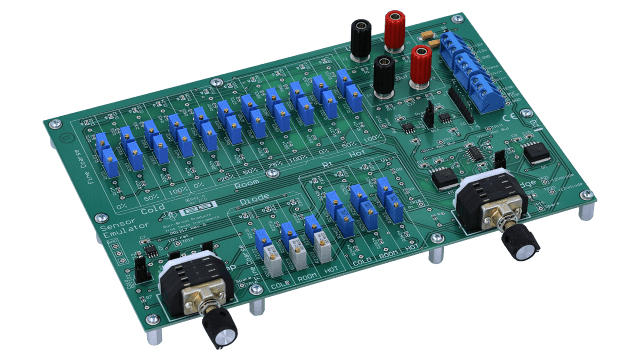Features for the SENSOREMULATOREVM
- Complete Strain and Temperature Emulation of Voltage-Excited Bridge Sensors
- Simplifies Development of Voltage-Excitation Bridge Sensor Signal Conditioning Systems
- Provides 11 Different Emulated Sensor Output Conditions
- Cold Temperature: 0%, 50%, 100%
- Room Temperature: 0%, 25%, 50%, 75%, 100%
- Hot Temperature: 0%, 50%, 100%
- Provides 3 Different Emulated Temperature Signals
- Cold Temperature
- Room Temperature
- Hot Temperature
- Provides 4 Different Temperature Sense Configurations
- Resistor in series with Top of Bridge Sensor
- Resistor in series with Bottom of Bridge Sensor
- Diode Voltage (On-Board Accurate Reference)
- Diode Voltage or Temperature Dependent Resistor (Sensor IC Current-Excited)
- LED Indicators provide “Emulation-at-a-Glance
- Requires External Power Supply: +/-12V
Description for the SENSOREMULATOREVM
The SensorEmulatorEVM provides a complete system for strain and temperature emulation of voltage-excited bridge sensors. The SensorEmulatorEVM uses rotary selector switches and potentiometers to emulate the operation of a voltage-excited Wheatstone resistive bridge sensor at discrete operating points of strain and temperature.
Once the sensor emulator has been programmed, it allows the user to cycle through a set of sensor output conditions very quickly. Doing this with a real sensor can be extremely time consuming because it can take several hours to cycle through various temperatures. Also, some sensors have non-repeatability issues. For example, pressure sensors can have pressure hysteresis and temperature hysteresis. The emulator does nothave non-repeatability issues (repeatability errors are typically less than 0.03%). This approach allows the user to program the sensor signal conditioning chip many different ways to quickly and easily assess the optimal calibration settings for a given application.
There are 11 different emulated sensor output conditions: Cold Temperature: 0%, 50%, 100%; Room Temperature: 0%, 25%, 50%, 75%, 100%; Hot Temperature: 0%, 50%, 100%. Each of these senor output conditions is easily selected by a rotary selector switch with a respective LED indicating the chosen condition. Three different emulated temperature signal levels can be programmed for cold temperature, room temperature, and hot temperature. In addition there are 4 different temperature sense configurations: resistor in series with top of bridge sensor; resistor in series with bottom of bridge sensor; diode voltage (on-board accurate reference); diode voltage or temperature dependent resistor (sensor IC current-excited). An external power supply of +/-12V is required to power the SensorEmulatorEVM.
Why not just use a precision voltage source to emulate a sensor? A precision voltage source is not affected by changing sensor excitation. Many sensor signal conditioning chips modulate the sensor excitation to compensate for sensor nonlinearity with applied strain. In this case (and in the case of a ratiometric system), a precision voltage source would not work. Also, it is much more convenient to have all the different sensor conditions pre-programmed so that you can quickly transition from one condition to another without having to reprogram the source at each different condition.
